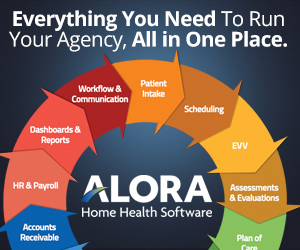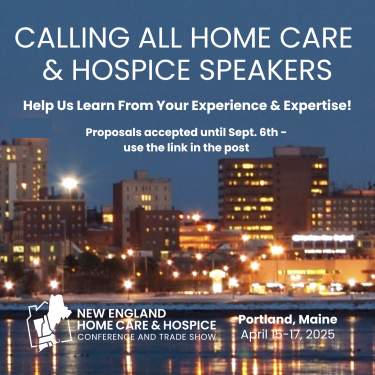 |
|||||||||||||||||||||||||||||
| August 8, 2024 | |||||||||||||||||||||||||||||
Source: The NAHC-NHPCO Alliance, July 30, 2024
On July 30, the Centers for Medicare & Medicaid Services (CMS) issued the fiscal year (FY) 2025 Hospice Wage Index and Payment Rate Update, Hospice Conditions of Participation Updates, and Hospice Quality Reporting Program final rule, which updates payment rates, the wage index, and the cap amount for FY 2025, and makes several changes to the Hospice Quality Reporting Program, CAHPS® Hospice Survey, and clarificatory changes to the Medicare hospice regulations and conditions of participation. The final rule also implements the Hospice Outcomes and Patient Evaluation (HOPE) data collection instrument beginning on or after October 1, 2025.
Here are the highlights:
The overall impact of the rule is an estimated $790 million in increased hospice payments.
Source: NAHC Report, August 1, 2024
The NAHC-NHPCO Alliance is continuing the process of integrating the two organizations into a single, cohesive champion for the care at home community. The member voice is critical to the success of this endeavor. As such, the Alliance hosted a member Town Hall on Wednesday, July 31.
Presenters provided updates on:
Listen to the Town Hall Recording on the Alliance News & Updates page.
Source: NAHC, July 29, 2024
On Monday, July 22, 2024, NAHC submitted comments on a Centers for Medicare & Medicaid Services (CMS) paperwork reduction act (PRA) notice regarding Methods for Assuring Access to Covered Medicaid Services. This PRA notice seeks to establish a mandatory data collection form that would be required when states seek to make rate reductions to covered Medicaid services.
In the comments, NAHC makes two recommendations:
The comment letter is available on the NAHC website HERE.
Source: NAHC Report, August 1, 2024
Expanded HHVBP Model Performance Feedback Reports
July 2024 Interim Performance Reports (IPRs) are Available on iQIES
The Preliminary July 2024 Interim Performance Reports (IPRs) for the expanded HHVBP Model have been published on the Internet Quality Improvement Evaluation System (iQIES). The quarterly IPRs provide HHAs with the cohort assignment, performance year measure data for the 12 most recent months, and interim Total Performance Score (TPS). Using the IPR, an HHA can assess and track their performance relative to peers in their respective cohort throughout the expanded Model performance year. The July IPRs also report preliminary Achievement Thresholds (AT) and Benchmarks (BM) by volume-based cohort for the quality measure set applicable to the third performance year, CY 2025, and following performance years, respectively.
Source: Susanna Welch, Senior Communications Manager at Axxess
The Centers for Medicare and Medicaid Services (CMS) created the Home Health Value-Based Purchasing (HHVBP) Model in 2016 to improve efficiency and quality in home health services and ensure the appropriate patients receive this care. Measuring baseline performance began in 2023. In 2025, providers will see a 5% increase or decrease in their reimbursement based on their performance relative to the baseline numbers.
To help organizations receive maximum payment for the services they provide, Axxess created a one-page reference guide that highlights common VBP risks and tips for success.
Arlene Maxim, RN, HCS-C, Senior Vice President of Clinical Services at Axxess, authored the reference guide and explained the strategies she recommends implementing to optimize VBP performance.
“The measurement and reporting of value-based care (VBC) in the home care industry is a benefit to us all,” Maxim said. “Having the ability to analyze and measure outcomes gives us the opportunity to show our value. But many organizations are still taking risks that could harm their VBP performance and ultimately their bottom line.”
It is everyone’s great hope that caregivers and at home providers will always be able to work in totally safe and secure environments, but as we have seen with all too much regularity, this is not always the case. The health industry needs a means to allow lone worker employees to easily react to emergencies by summoning help in a discrete manner. The company I work for, CMS, is located in CT and produces the required products.
Recent legislation, SB1, empowered the Department of Public Health to recommend a personal emergency response system for all healthcare agencies. The state recommends that such a system should be a GPS enabled wearable device capable of sending a distress signal to first responders at the touch of a button. That is exactly how our Soteria Shield product operates.
We provide a HIPAA-compliant wearable panic button contained in a variety of forms. All of them contain the help button and work to ensure staff safety.
Source: Hospital & Healthcare Compensation Services, June 2024
The HCS Home Care and Hospice Salary & Benefits studies are now underway! This is the fifth year the Connecticut Association for Healthcare at Home (CAHCH) has partnered with Hospital & Healthcare Compensation Service (HCS) on the studies. Both studies are also published in cooperation with the National Association for Home Care & Hospice.
The reports are recognized as the authoritative source for comprehensive marketplace data for home health hospice agencies. Last year’s Home Care Report contained data from 1,018 home health agencies and included data from 16 Connecticut agencies. The Hospice Report had data from 704 hospice agencies and included data from 10 Connecticut agencies.
Both studies include questions on staffing issues, nursing vacancy turnover rates and sign-on bonuses used by agencies to attract new employees. The results cover job data by salary, hourly and per-visit rates with job data breakouts by auspice, revenue size, region, state and CBSA. Regional data for 19 fringe benefits, planned salary increases, productivity, caseload and shift differential data are also covered.
We are so excited to announce that our CEO Marcus has been named an honoree for the Cystic Fibrosis Foundation 2024 CT’s Finest!
We are incredibly proud of this recognition and excited to support such an important cause! Cystic Fibrosis (CF) is a progressive, genetic disease that affects the lungs, pancreas, and other organs. In people with CF, mutations in the cystic fibrosis transmembrane conductance regulator (CFTR) gene cause the CFTR protein to become dysfunctional. When the protein is not working correctly, it’s unable to help move chloride — a component of salt — to the cell surface. Without the chloride to attract water to the cell surface, the mucus in various organs becomes thick and sticky. In the lungs, the mucus clogs the airways and traps germs, like bacteria, leading to infections, inflammation, respiratory failure, and other complications. For this reason, avoiding germs is a top concern for people with CF. In the pancreas, the buildup of mucus prevents the release of digestive enzymes that help the body absorb food and key nutrients, resulting in malnutrition and poor growth. In the liver, the thick mucus can block the bile duct, causing liver disease.
Change Inc. is coming together with Marcus to raise awareness and provide support for those with CF. We are asking for your help in our endeavor!
|
|||||||||||||||||||||||||||||
| Past Issues | Subscribe | cthealthcareathome.org | Advertise with Us | |||||||||||||||||||||||||||||






